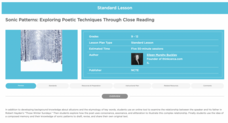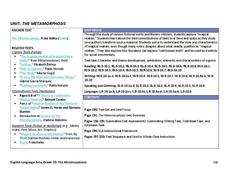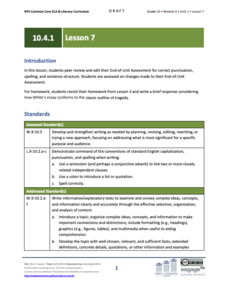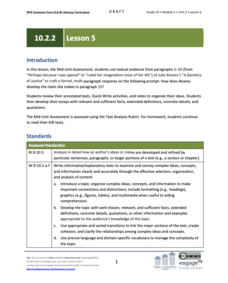ReadWriteThink
Sonic Patterns: Exploring Poetic Techniques Through Close Reading
Robert Hayden's poem "Those Winter Sundays" serves as the anchor text in a five-part lesson that takes the mystery out of poetry analysis by modeling explicit strategies for pupils to employ to conduct a close reading of a poem. After...
Orange Public Schools
Stagecraft
The house lights dim, the curtain parts, lights slowly come up, revealing the stage. Before the actors appear, before a word is spoken, the audience is drawn in by the lighting, by the colors, by lines of the set, by the props, and...
Louisiana Department of Education
The Metamorphosis
How can something be true even if it didn't happen? Invite your classes to investigate the truths found in the world of magical realism as they analyze short stories, poems, informational texts, video, and art from this genre.
Common Sense Media
My Online Code
Approach ethical online behavior with a series of activities geared toward teaching pupils about digital citizenship. After a brief discussion about ethics, small groups inspect a fictional social networking profile with ethics in mind....
Nebraska Department of Education
Leaving A Job
Neither "You're fired!" nor "I quit!" make for leaving a job on good terms. As part of a career development study, job seekers learn to craft both a verbal resignation and a formal resignation letter.
Nebraska Department of Education
Writing Emails That Matter
LOL! BRB! :-) The rules for business and professional emails differ significantly from online communications among friends. As part of a career readiness study, pupils learn the do's and don'ts of writing professional emails.
Curated OER
Creative God or Goddess
Who causes sinkholes? Or acid rain? High schoolers try their hand at myth-making as individuals create a god or goddess responsible for the modern-day phenomenon. They introduce their deity in an essay that reveals the name, parentage,...
ReadWriteThink
Heroes Are Made of This: Studying the Character of Heroes
What makes heroes and villains? A six-part unit plan asks young scholars to explore the concept of heroism and the characteristics they consider heroic and unheroic. Groups create character maps that focus on how characters are shaped by...
National Park Service
Lesson 6: Researching Contemporary Slavery
While many believe slavery ended after the American Civil War, it continues today in various forms. Using a WebQuest research project, class members investigate how the institution of slavery lives on in the modern world. Activities also...
Radford University
Your School’s Athletic Director Needs Your Mathematical Input!
Cover the field. Pairs investigate two different rolls of astroturf to cover a football field. The learners determine which type of roll is the most cost effective. Scholars write letters to the athletic director explaining their...
Radford University
Fire Truck Presentation
Which truck should the fire department purchase? Given a scenario with three different ladder trucks, pupil compare the height the ladders will reach. They determine which ladder trucks meet the cities' requirements and provide a...
Radford University
How Tall is the Tree?
Pairs or small groups work together to determine the height of a tree using similar triangles. Learners make a judgement which direction to let a tree fall to avoid hitting any structures. They then write letters to the principal...
Radford University
Building a Recreation Center
It's all about location, location, location. Small groups work to find the best spot for a rec center to serve three different communities. Learners construct the inscribed and circumscribed circles of a triangle to find the best place....
EngageNY
Grade 10 ELA Module 4, Unit 2, Lesson 26
How do directors' choices emphasize different elements of a drama? Scholars participate in a discussion about the Royal Shakespeare Company production of Macbeth and Akira Kurosawa's Throne of Blood. Finally, they write an analysis of...
EngageNY
Grade 10 ELA Module 4, Unit 2, Lesson 25
How do film adaptations differ from their literary counterparts? Scholars watch and analyze the 2011 Royal Shakespeare Company (RSC) production of Shakespeare's Macbeth. Pupils complete a Quick Write analyzing how the RSC production...
EngageNY
Grade 10 ELA Module 4: Unit 2, Lesson 8
Shakespeare's Macbeth has something for everyone. Scholars complete a mid-unit assessment. They craft multi-paragraph essays to analyze how the author's structural choices create tension and suspense in the play's first two acts.
EngageNY
Grade 10 ELA Module 4: Unit 1, Lesson 7
High school writers participate in peer review of their end-of-unit tasks. They begin by discussing their thought process in pairs and then editing their work. Finally, learners participate in a class discussion on the use of the...
EngageNY
Grade 10 ELA Module 4: Unit 1, Lesson 6
It's time to tie it all together. Scholars reflect on the series' past five lessons about Death of the Pig. They examine how E.B. White develops a central idea throughout the essay before responding to a writing prompt.
EngageNY
Grade 10 ELA Module 4: Unit 1, Lesson 5
Learners prepare for the end-of-unit task by evaluating previous homework and writing sentences with parallel structure and various phrases. Scholars do this by closely examining E.B. White's Death of a Pig. They examine the structure of...
EngageNY
Grade 10 ELA Module 3: Unit 1, Lesson 15
It's time for the grand finale! Scholars finalize their learning in a two-part end-of-unit assessment. This assessment covers multiple standards as learners demonstrate their understanding of the central idea, comprehension, and...
EngageNY
Grade 10 ELA Module 2: Unit 3, Lesson 7
It's time to show what you know. The final activity asks scholars to reflect on the seven-lesson plan unit and complete an end-of-unit task. Readers consider the claims presented in speeches by Eleanor Roosevelt and Malala Yousafzai...
EngageNY
Grade 10 ELA Module 2: Unit 2, Lesson 10
All good things must come to an end! Scholars put all their learning into practice by completing an end-of-unit assessment. They use textual evidence from Julia Alvarez's "A Genetics of Justice" to write essays analyzing how Alvarez...
EngageNY
Grade 10 ELA Module 2: Unit 2, Lesson 5
How do learners use textual evidence from a close reading to write a well-developed essay? Scholars try it by completing a mid-unit assessment based on their analysis of the first 15 paragraphs from "A Genetics of Justice" by Julia...
EngageNY
Grade 10 ELA Module 2: Unit 1, Lesson 20
Readers take all the information they gained from the last 19 lessons and complete an essay describing how King develops his purpose and claim in "Letter from Birmingham Jail." Pupils use a rubric and checklist to help guide their...

























